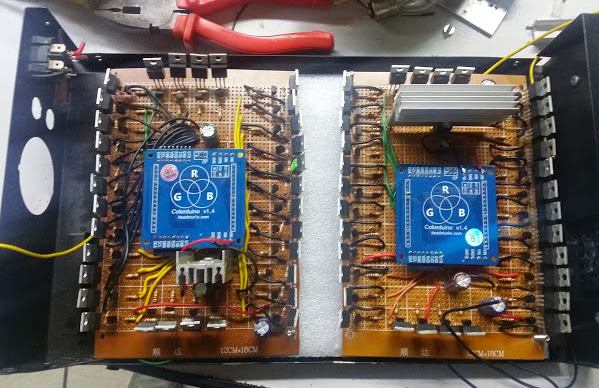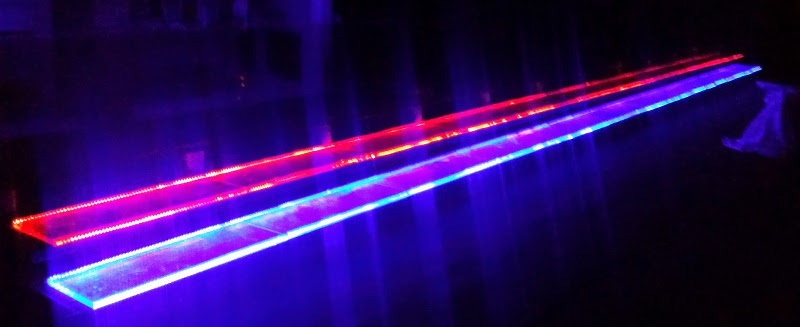In a well documented blog entry, [Loren Bufanu] presents a project that lit up a glass dance floor covering a swimming pool with RGB strips. We mentioned a video of his project in a Hackaday links but didn’t have any background information. Now we do.
 The project took around 450 meters of RGB strips controlled by two Rainbowduinos and driven by sixty-four power Mosfets, sixty-four bipolar transistors, and a few other components. Producing white light from the LEDs draws 8 amps from the power supply.
The project took around 450 meters of RGB strips controlled by two Rainbowduinos and driven by sixty-four power Mosfets, sixty-four bipolar transistors, and a few other components. Producing white light from the LEDs draws 8 amps from the power supply.
The Rainbowduino is an ATmega328 Arduino compatible board with two MY9221 controllers. Each controller handles 12 channels of Adaptive Pulse Density Modulation. In other words, it makes the LEDs flash nicely. [Loren] used the Rainbowduino instead of some alternatives because multiple R’duinos can coordinate their activities over I2C.
The software part of the project did not work as well as the hardware. The light patterns were supposed to follow the music being played. A PC software package intended to drive the R’duinos produced just a muddy mess. Some kludges, including screen captures (!), driven by a batch file tamed the unruliness.
It’s been awhile, but a similar disco dance floor, built by [Chris Williamson] but not over a pool, previously caught our attention. [Chris] is a principle in Terror Tech that recently got a mention on Sparkfun.
The video after the break fortunately does not make a big splash, but is still electrifying.
















If one would be to sync light to music I would really suggest Winamp visualization plugin development… I would say they got the sync part pretty well covered and that you just have to spit out bits like you would like them to be spitted.
That’s actually Milkdrop, and he’s doing that. But some other kind of audio visualization.
Read man, read :)
Unfortunately, in this video, the lights are not synchronized with the music. The music you hear is playing from a phone. Like i sayd in my blog, im not in the location to make another video. But when synchronized, it’s looking awesome. Also a row of LED’s shown in the video are not connected. When i recorderd, i had to leave a unconnected row for making it possible to hide all wires. I will post a video with the final result as soon as i can.
> Just the white LEDs
Wait, what? I didn’t know that RGB LED strips also have white LEDs.
> 8 amps of power.
Wow, 8 amps! That’s more than a 6 kW motor running on three phase 400V pulls!
/s
Seems like the quality of HaD articles really is going down… White is made by adding R(ed), G(reen) and B(lue) together. And amps are for measuring current, not power. 8 amps @ 1V is less power than 8 amps @ 230V. sigh.
I fixed it. Just poor wording on my part. Please be ‘un-annoyed’.
Thanks!
“when all 3 leds are on”, basically. Idt the strips have dedicated white.
That’s why there was a ‘/s’ at the end.
Due the long cables the voltage drop for each led strip seems to be for me huge issue (and the current of 135A at 12V are also a big issue), wouldn’t it be a better approach to use multiple driver circuit modules with an integrated step-down converter? You would also save a lot of money due to cheaper cables, even if you use one driver module for 4 panels.
Peter, it’s not 8 amps for each strip. It is from all the LED’s together, from both controllers. I sayd over 8 because measure wkith white light, the current draw was about 8.35 or …,/on 12 v. But i experimented as far as 16 volts . the wires used were normal 1.5 mm wires
I had a recent customer request a LED system that synced to music. There was no dance floor, the lights were in the water. I hired a programmer and he used a raspberry pi and it worked perfectly.